The Alocasia Polly, also known as the Alocasia x Amazonica and African Mask plant, is probably best known for its intricate and vivid dark emerald-like leaves with thick and bright veins. It’s a tropical plant, just like most other Alocasia plants. This plant may demand some more care from its owner and may not be the best plant to start with if you’re a beginner. In this article, we’ll discuss how to care for Alocasia Polly.
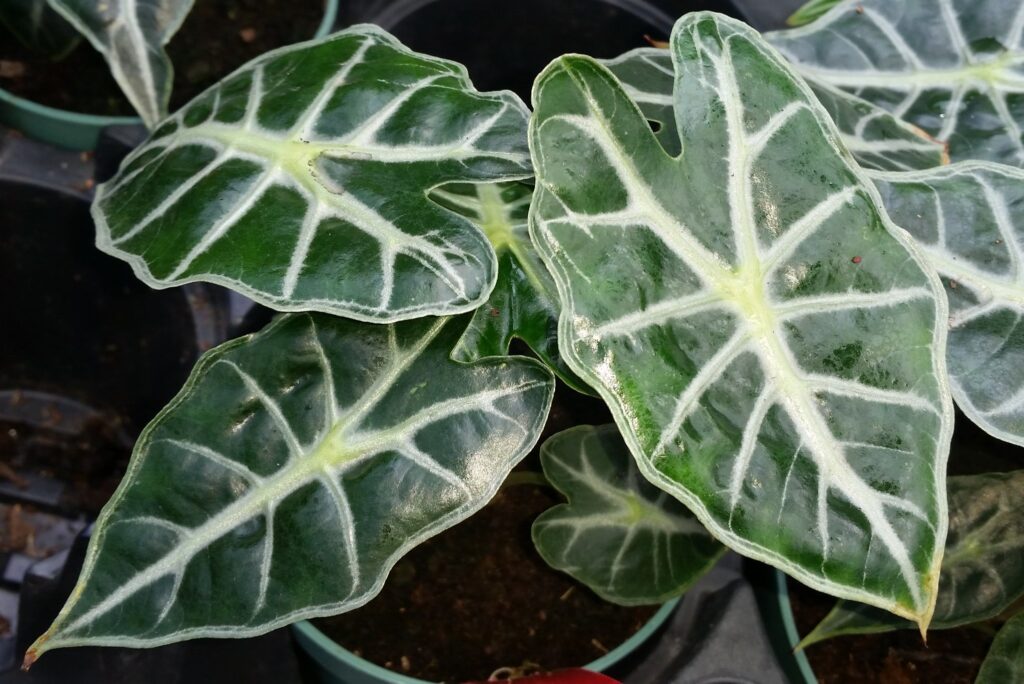
However, when you give it its ideal growing conditions, it will graciously give your indoor space a tropical and luxurious growth that will last throughout the years. If you can take care of this plant, you can move on to more advanced plants.
We’ll go over the most common questions that most people have in regards to its plant care, where most people go wrong, and some tips and tricks to keep your Alocasia Polly healthy and happily thriving.
Alocasia Polly Plants Overview
The origin of this Elephant Ear Plant is confusing to scientists and horticulturists, as this plant has been riddled with one of the most horticultural myths. This Alocasia plant is actually a hybrid from Alocasia longiloba x Alocasia sanderiana, and is not a species or cultivar.
Some sellers may advertise this plant as coming straight from the rainforests of Asia or South America, but that is totally false. Its parent plants, however, have origins in Asia. This plant is named after Salvadore Mauro’s plant nursery, “Amazon Nursery,” in honor of his nursery.
Alocasia Polly General Care
Generally speaking, you will want to grow this plant in airy soil that does not easily compact and that the soil drains well. You will want to water this plant when the top two to three inches of the soil feels dry and keep moisture levels of the plant moderate.
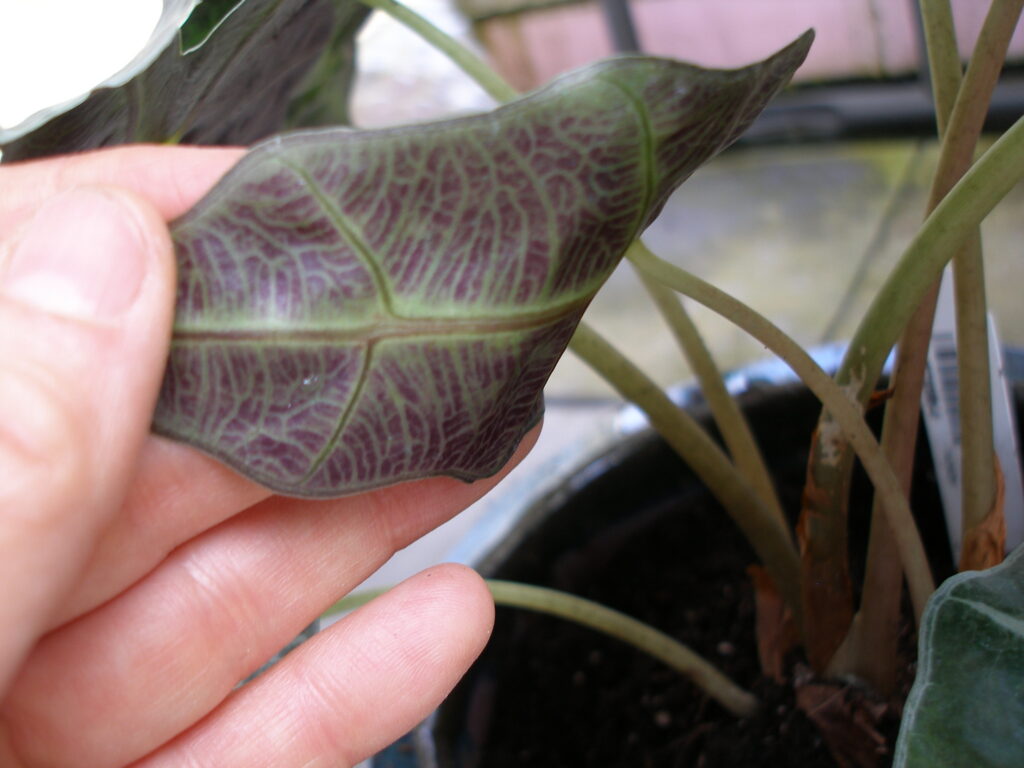
Place it in a sunny location with ideal indoor temperatures from 65॰F to 80॰F (18°C to 27°C). Fertilize this plant once to twice a month only in its growing season.
Whether or not you are just a beginner to growing Alocasias or just wanting to add diversity to your collections, we encourage you to keep reading as we’ll demystify everything about this plant.
1. How should I water my Alocasia Polly?
Most Alocasias are tropical, which means that they will need quite a bit of watering and moisture. However, the Alocasia Polly is different; it has thick stems which allow them to store moisture and does not solely rely on the moisture from the soil to keep itself hydrated. With this in mind, you should only water your Alocasia Polly when the soil is dry.
The plant is sensitive to overwatering. Therefore, keep the soil moist but never soggy, especially during spring through summer growing seasons. Allowing the soil dry in between watering ensures the plant from overwatering.
To determine the soil’s moisture levels, stick your finger into the soil, and if the top inch starts to feel dry to touch, apply water until it runs from the pot’s bottom drain holes. In winter, the plant may undergo dormancy and stop actively growing; therefore will not need as much watering.
One trick to know whether you need to water your Alocasia Amazonica Polly is feeling for its weight. When you get this plant for the first time, water it sufficiently. Then lift your plant up and feel its weight. This will give you an idea of how heavy your plant is after being watered. After two weeks, the soil should be dry. Lift your plant up again and feel the difference in weight.
At this point, your plant should be lighter, which will tell you that your plant will need to be watered. This trick can be used throughout the year; water your plant only when it’s light again.
RELATED: Alocasia wentii: The #1 Care, Watering, and Propagation Guide
2. What kind of light does my Alocasia Polly require?
To keep your Alocasia Polly happily thriving and for its fronds to retain their vibrant green colors, place your plant in a location that receives bright indirect light but not direct sunlight. Adult leaves can tolerate direct sunlight for a while, but their new leaves can burn and dry out under the same conditions.
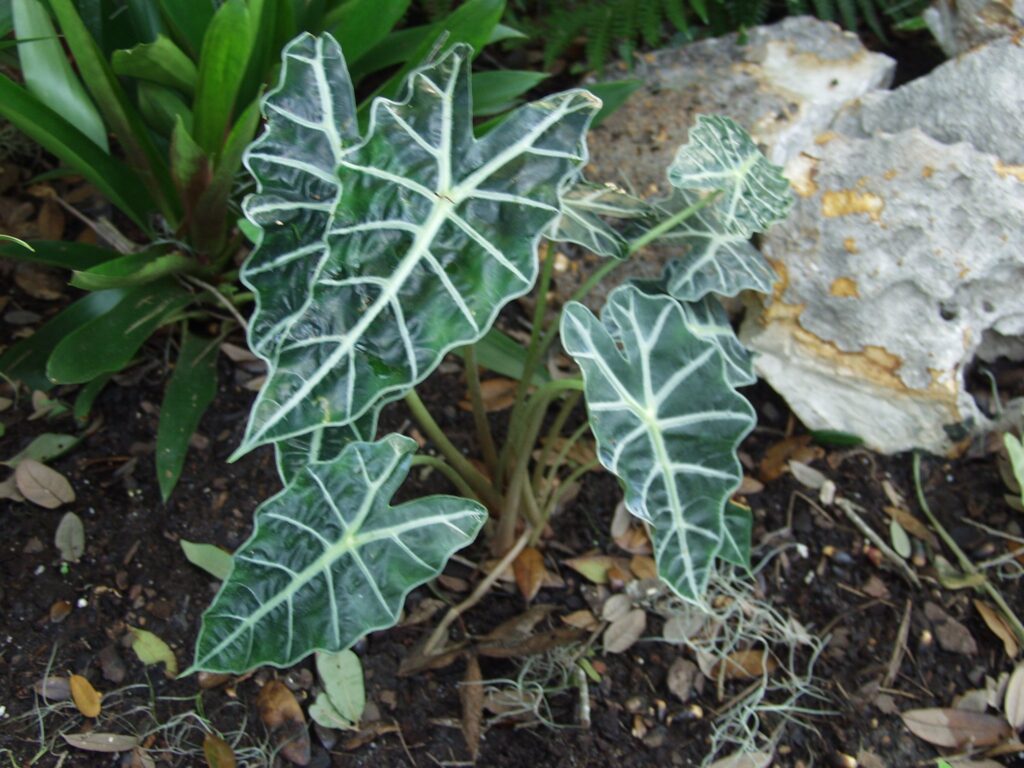
However, if you are in an area where light and temperature conditions are not as intense, you can place this in direct sunlight. If you start noticing brown edges on the leaves of your Alocasia Polly, this means it is receiving too much sunlight. Therefore, relocate them to a place with less harsh light conditions.
This Alocasia plant will also not tolerate low light conditions. If they are placed in these conditions, the leaves will lose their colors and their thick veins. The plant can eventually die as a result. Even when placed in moderate lighting conditions, the plant will not thrive as happy and will not produce the best growth compared to being placed in a brighter location.
3. What is the perfect soil for my Alocasia Polly?
As we’ve discussed earlier regarding watering, the Alocasia Polly stores water in its thick stems and does not depend heavily on the soil for its moisture requirements. Therefore, its soil must cater to this as well. The ideal soil would be one that drains water well, where water does not stay in the soil for more than a few days, and is aerated well.
Heavier soils have a greater risk to retain extreme moisture. If your Alocasia Polly sits in water for too long, it can suffer from root rot.
If you want to create your own growing medium, it should compose of bark, perlite, coconut coir, horticultural charcoal, and worm castings. This will give the Alocasia Polly a well-aerated soil that provides plenty of nutrition and sufficient moisture while reducing the risk of root rot.
Aside from planting your Alocasia Polly in soil, you can also plant it in Leca. This soil medium allows sufficient water to reach your plant’s roots while also allowing plenty of oxygen to reach your plant’s roots.
4. How should I fertilize my Alocasia Polly?
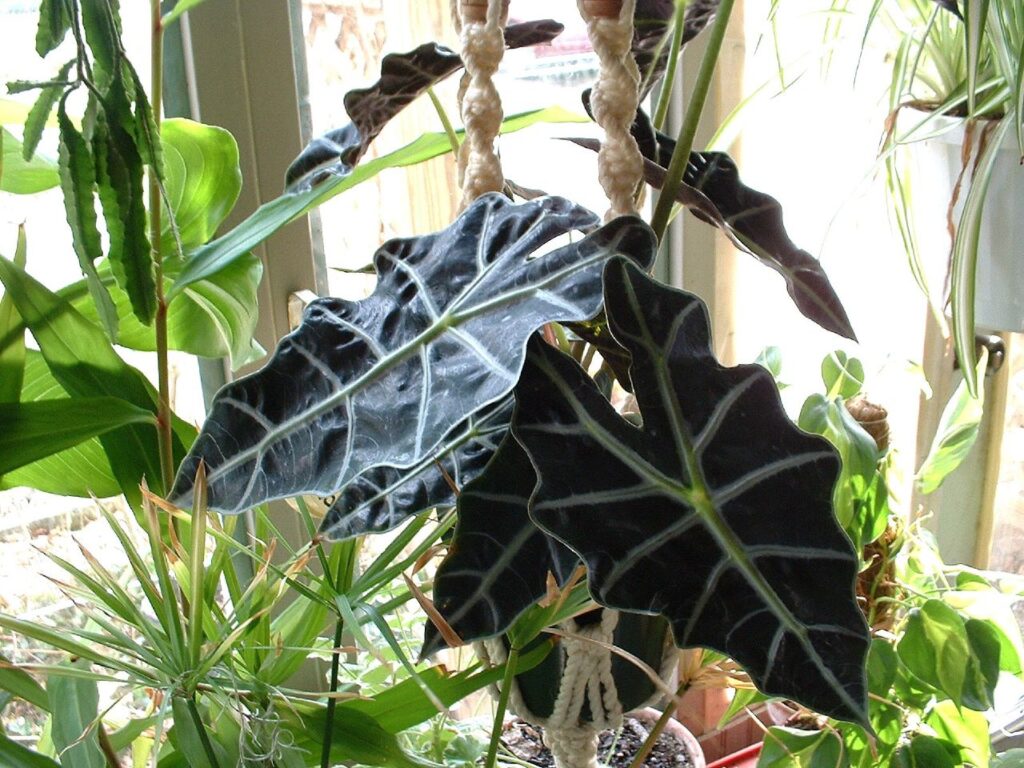
These plants can grow quite enormously in a relatively short period of time as compared to other houseplants. Sometimes, you can even catch your Alocasia Polly blooming throughout the year. This means that your plant uses a lot of resources for it to grow swiftly. Therefore, your fertilizing schedule should cater to these needs.
Fertilize it once a month in its growing season of spring and summer and once per quarter in the fall and winter. In the winter, you can even completely stop fertilization since the plant stops actively growing this season.
Your Alocasia Polly can be fertilized using liquid fertilizer or even fertilizing sticks. When you use sticks, be sure to follow package instructions. These sticks will last for about 100 days. Another option is to use slow-release granules on top of the soil, which will slowly break down over the course of several months.
This will provide sufficient feed for your plant throughout a growing season. However, do take note not to use an extremely strong blend of fertilizer as this can end up burning the foliage through salt buildup. For this reason, natural fertilizers are better since they are much more gentle and can help prevent nutrient burns.
RELATED: Alocasia Bambino: A Full and Easy Care, Propagation, and Watering Guide
5. What is the ideal temperature for my Alocasia Polly to thrive in?
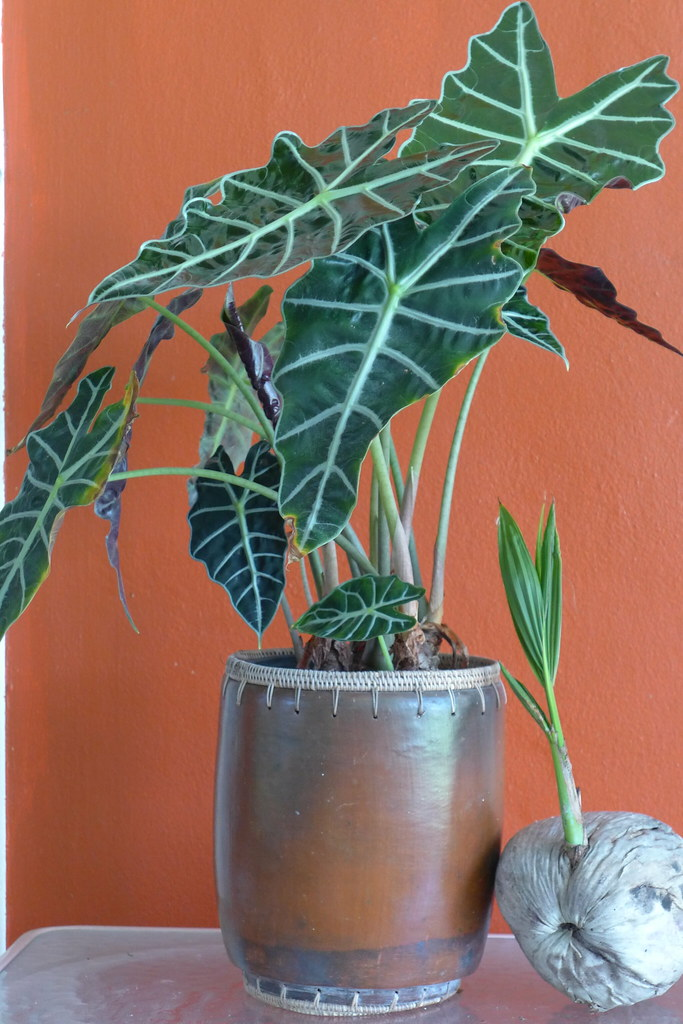
Like its parental origins, Alocasia Polly loves growing in warm temperatures. When temperatures drop under 55°F (13°C), the plant will completely go into dormancy, and its gorgeous fronds and foliage can lead to death.
However, the bulb can remain alive despite the foliage dying, and foliage will resprout when temperatures begin warming up in the spring. This process does take few months, though.
To maintain your Alocasia Polly happily thriving, its best to keep its indoor growing temperatures between 65 degrees Fahrenheit and 85 degrees Fahrenheit (18°C to 27°C). Also, be sure to keep this plant away from any heating elements or air conditioning vents, as these can make air too dry for the plant to tolerate.
6. Are there any humidity requirements for my Alocasia Polly?
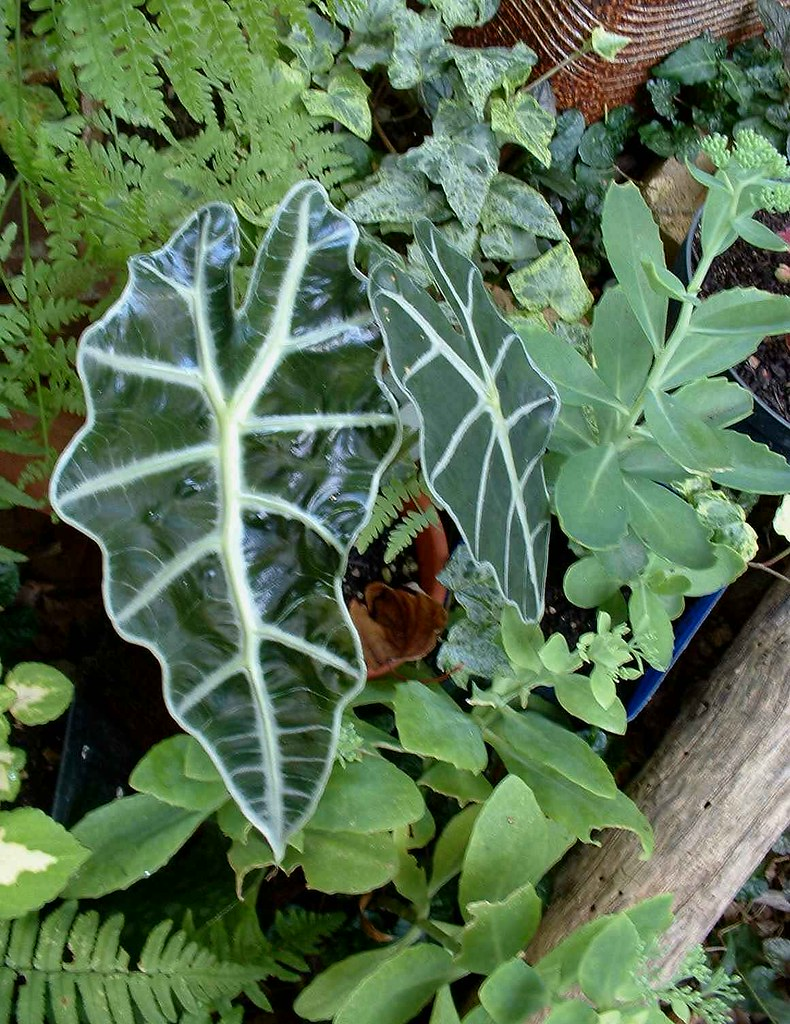
We’ve already talked about how the Alocasia Polly is a tropical plant. Therefore, this plant requires more moisture for it to maintain healthy fronds. For some, it may be challenging to maintain rainforest-like conditions indoors. However, creating moisture for house plants is generally easy.
For one, you can put the Alocasia Polly’s container on top of a tray with pebbles. This way, excess water will pool on the tray whenever you water the plant. The water will provide your Alocasia with its much-needed moisture. You can also mist the plant’s foliage one to two times per week.
Finally, if your bathroom or your kitchen has enough light for proper development, their humid conditions can be enough to support your Alocasia’s growth.
7. Do I need to regularly prune my Alocasia Polly? How do I maintain its foliage?
Besides the removal of dead or damaged leaves, you won’t need to regularly prune or deadhead your Alocasia Polly. This will just keep your plant looking fresh and well kept. However, take note that when there is a need to prune a stem or leaf, do so with clean and sterile tools to prevent the transmission of disease or pests from one plant to the next.
To do this, simply wipe your blades off using alcohol or a disinfectant such as bleach. After this step, you are now ready to start pruning dead leaves.
8. Is repotting necessary for my Alocasia Polly?
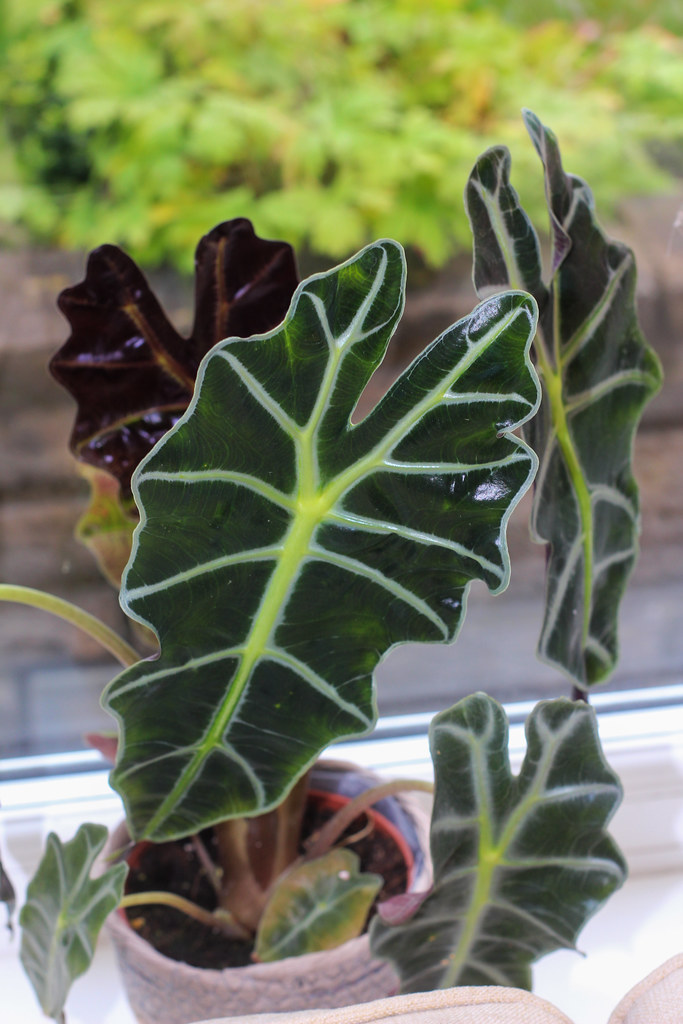
You would only want to repot your Alocasia Polly if you received it in a very tiny pot. Besides that, you won’t need to repot your Alocasia Polly until it absolutely outgrows its container. You will see this as roots exiting the pot’s drainage holes.
Depending on its rate of growth, you may not need to repot this for several years; more often, the reason for doing so is to refresh the growing medium. If you do decide to repot this plant, do so during the beginning of its growing season in the spring.
Repot the Alocasia in a container that is larger than its present one for one size. Repotting in an extremely large container means that the soil will not dry out as fast and will remain soggy for your Alocasia Polly to tolerate. Make sure that its new container has sufficient drainage holes. For the potting mix, refer to the previous question regarding soil.
To actually repot, follow these steps:
- Remove your Alocasia Polly from its previous pot carefully and inspect the root ball. If there is any wrapping, tease them gently apart using your fingers.
- Fill its new container three-fourths up with the proper soil mixture, then water it slightly to allow it to settle.
- Place your Alocasia Polly in its new pot and add or remove soil as you deem necessary so that it isn’t planted deeper than intended. Planting any deeper will put stress on your plant.
- Fill up the remaining space with soil and firm it around your plant.
- Water the soil until it leaks from the bottom drainage holes. Place it back to the original locations where you were growing it.
9. I want more of these lovely plants! How do I propagate my Alocasia Polly?
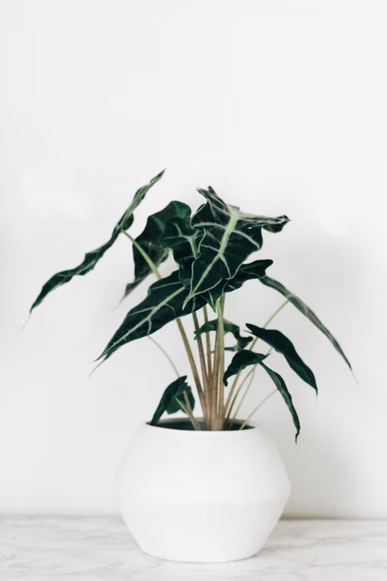
On the rare occasion that your Alocasia Polly blooms a greenish-yellow spathe, the seeds it produces are most likely sterile. So the only way to propagate additional plants is by dividing offshoots from the mother plant.
When dividing from the mother plant, it’s best to do so in its growing season in the spring. You can also go through this core when you repot your plant.
Here is the step-by-step guide:
- Lay out a newspaper to which to lay your Alocasia Polly after it has been removed from its pots. If there is root wrapping, tease them gently apart using your hands before dividing the plant.
- Where your Alocasia Polly has produced offshoots, gather as many roots as possibly as you can. Then, pull it apart from your mother plant. Use sterile pruning snips as you deem necessary to snip them off from the mother plant cleanly. Be careful to avoid cutting offshoot’s center.
- Pot the offshoot in an appropriately sized container that has drainage holes and with proper soil.
- Place the baby plant in similar conditions as the mother plant. Enjoy your new Alocasia Polly!
RELATED: Alocasia Mickey Mouse: A Useful and Complete Care, Propagation, and Watering Guide
10. Do I need to regularly clean the leaves of my Alocasia Polly?
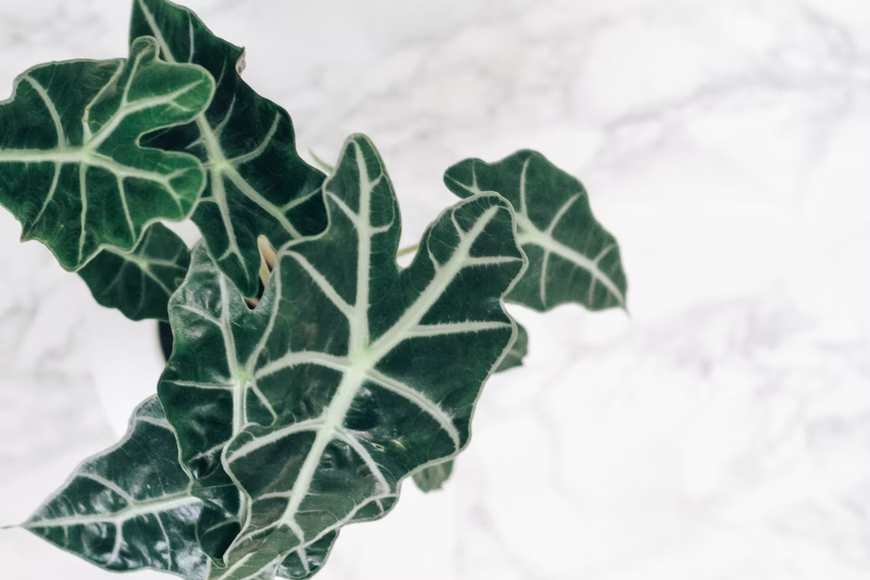
The frequency of cleaning your Alocasia Polly’s leaves will depend on how dusty you your home is. Keeping its frond neat not only maintains the plant looking dapper but also maintains your plant healthy by allowing it to photosynthesize more effectively.
Doing so is easy. You can take your plant to a sink and wash the leaves with lukewarm water. Alternatively, you can use a mixture of 1/4th teaspoon of mild dishwashing soap with a quarter of room temperature water.se this mixture to spray the foliage, then rinse the soap off with water.
Finally, you can also use a moist cloth to dust off the leaves of your plant.
11. My Alocasia Polly is not thriving as happily as it could. What are the possible problems?
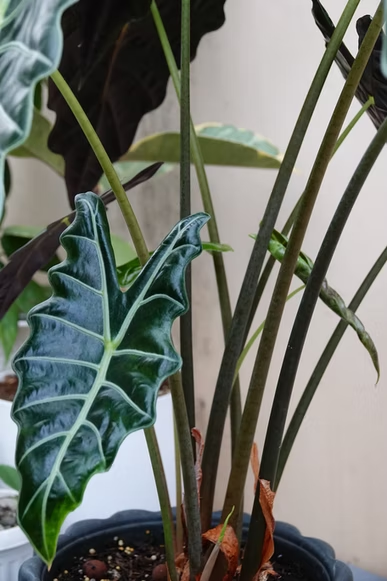
- Black stems and leaves
The Alocasia Polly is rarely plagued with disease, especially when given its ideal growing conditions. As with most aroid plants, the biggest problem to this plant is root rotting caused by extremely wet growing conditions. This usually manifests as parts of the plant’s base and leaves developing black portions.
If too much of the plant reaches this point, the plant usually dies. If caught early, here are some steps you can do to check for rotting and save your Alocasia Polly
First, remove your Alocasia Polly from its container and gently rough up any dirt from its roots. Next, inspect sections that may have been affected by rot damage. This will show as roots and bulbs that are mushy and soft. If damage is minimal, cut the affected sections by rot with clean, sterile shears.
When rot is more extensive, affecting large portions of the bulb and roots, it’s best to say goodbye to the plant. If your plant still can be saved, place fresh new growing soil into a pot. Plant your Alocasia and hold watering for a few days.
Resume regular watering by moistening the soil first and only water when the soil begins to be dry and cracky.
- Yellow leaves
An Alocasia Polly can maintain only a certain number of leaves before getting rid of old leaves. In this process, the plant will turn its older leaves yellow before dying. This means that the plant is killing old leaves to preserve energy or is about to grow new leaves.
However, this can also be another sign of faulty watering schedules. It may be a sign both for overwatering and underwatering. When this happens, just make sure that you are on point with your watering. Only start watering when the topsoil just starts to feel dry to the touch.
- Brown leaves
There are usually two things that can cause its leaves to brown. One is if your plant is not having enough humidity. This will cause its edges to brown. Check back on the humidity tips for this plant in order to resolve this issue. The other cause is due to overfertilizing, as excess salts can also cause leaf edges to brown.
To flush the salts from the soil, use a slow jet of water for at least five minutes. Do this every 2-3 months. Additionally, you can cut back on the frequency of your fertilization schedule.
- Pest problems
The most common pest you may encounter with an indoor Alocasia Polly is the notorious spider mites. In general, these pests will siphon the juices from the plant’s leaves and can eventually result in your plant’s demise if not controlled quickly. Unfortunately, what’s worse is that they can also infect your other houseplants.
This is easily identifiable as these insects will spin webs around your plant’s fronds and foliage. To treat these pests, you can spray both the bottom and top sides of the foliage with commercially available insecticide or a natural insecticide such as neem oil. Always follow the instructions for use regarding these products.
12. Is my Alocasia Polly toxic?
This plant is high in calcium oxalate crystals which are almost in the entirety of the plant. This compound is extremely toxic to dogs, cats, other livestock, and of course, to people. Ingestion of your plant will cause burning sensations in the mouth and can potentially lead to airway swelling and harm. The sap can even cause irritations to the skin.
When taking care of this fantastic plant, make sure to place it out of your pets and children.
Conclusion
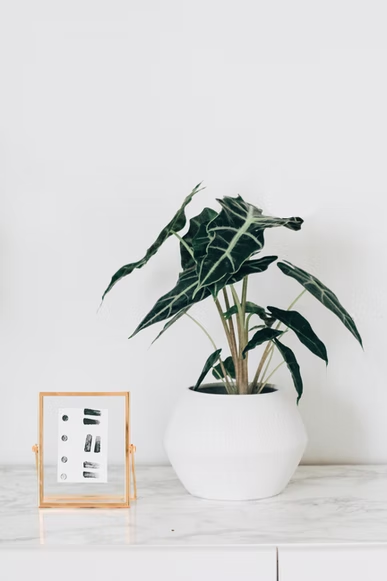
Like any other Alocasias you may come across, the Alocasia Polly has very similar care requirements to its cousins. It does, however, have some quirks that will allow it to not only optimally but happily thrive as well. This plant does not rely too much on the soil for its water requirements due to its stems storing enough water.
It is also a relatively fast-growing plant. It does love a bright spot but will not like direct sunlight exposure. Giving enough care and getting to know its quirks will reward you with its deep, intriguing green foliage. It will serve you long and for years to come.







